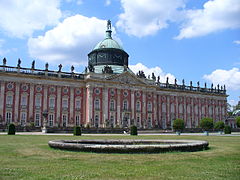Neues Palais
| New Palace | |
|---|---|
| Neues Palais | |

The New Palace in Sanssouci Park
|
|
|
Location in Germany
|
|
| General information | |
| Type | Palace |
| Architectural style |
Baroque, Rococo |
| Town or city | Potsdam |
| Country | Germany |
| Coordinates | 52°24′N 13°01′E / 52.40°N 13.01°E |
| Construction started | 1763 |
| Completed | 1769 |
| Client | Frederick the Great |
| Owner | Stiftung Preußische Schlösser und Gärten Berlin-Brandenburg |
| Design and construction | |
| Architect |
Johann Gottfried Büring, Heinrich Ludwig Manger, Carl von Gontard |
| Website | |
| Stiftung Preußische Schlösser und Gärten | |
The New Palace (German: Neues Palais) is a palace situated on the western side of the Sanssouci park in Potsdam, Germany. The building was begun in 1763, after the end of the Seven Years' War, under King Friedrich II (Frederick the Great) and was completed in 1769. It is considered to be the last great Prussian baroque palace.
The building of the palace commenced at the end of the Seven Years' War, to celebrate Prussia’s success. The war is also variably referred to as the Third Silesian War, owing to the dispute over Silesia. In an architectural form, Frederick the Great sought to demonstrate the power and glories of Prussia attributing it as fanfaronade, an excess of splendor in marble, stone and gilt.
For the King, the New Palace was not a principal residence, but a display for the reception of important royals and dignitaries. Of the over 200 rooms, four principal gathering rooms and a theater were available for royal functions, balls and state occasions. During his occasional stays at the palace, Frederick occupied a suite of rooms at the southern end of the building, composed of two antechambers, a study, a concert room, a dining salon and a bedroom, among others.
After the death of Frederick the Great in 1786, the New Palace fell into disuse and was rarely occupied as a residence or entertainment venue. However, starting in 1859 it became the summer residence of the German Crown Prince, Frederick William, later German Emperor Frederick III. The palace was the preferred residence of Frederick and his empress, Victoria, throughout the 99 Days’ Reign. During the short reign of Frederick III, the palace was renamed "Friedrichskron Palace" (Schloss Friedrichskron) and a moat was dug around the palace. The ascension of Wilhelm II saw renovation and restoration within the palace being carried out with the installation of steam heating, bathrooms in state apartments and electrification of the chandeliers which Frederick the Great had collected from across Europe. Until 1918, it remained the preferred residence of Wilhelm II and the Empress Augusta.
...
Wikipedia

